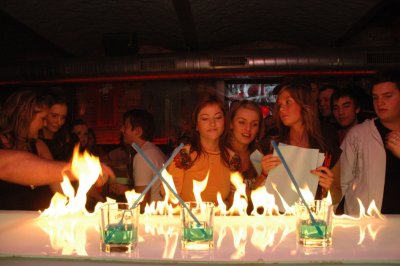
Firey absinth fun – Czech style 🙂
Posted in absinth, absinthe ritual, Czech, Czech Absinth
Josef Čapek (1887 -1945) is a name that every Czech knows for his beautiful illustrations. Like Josef Lada he presents a charming naive beauty to his most famous playful illustrations. The above lithograph – The Absinthe Drinkers- is obviously Cubist and dates to the period of the First Republic. Josef Čapek invented the term “robot” – see http://capek.misto.cz/english/robot.html
The photograph below shows Josef in the centre with his brother Karel and Olga Scheinpflugova. Karel, who is considered to be one of the most important Czech writers of the 20th Century, was a Czech nationalist and a critic of fascism. Karel died in December 1938, before the Gestapo could get to him. Josef was arrested after the Nazi criminals came to Prague and his life ended, along with so many others, at Bergen-Belsen concentration camp.
For more information on Karel and Josef Čapek please visit http://capek.misto.cz
Posted in absinth history, culture, Czech, Czech Republic
Czech Expression of the Day: Bez práce nejsou koláče. Without work, there is no cake. The cake pictured is known as a Bábovka – not to be consfused with babička (grandmother) . In Australia you can now buy a Czech made wormwood flavoured vodka named Babicka 🙂
PS: Medovnik, or honey cake, which is served everywhere thesedays in Prague, is not Czech – it’s Russian!
Posted in Czech, Czech Expressions, Czech Republic
Bottling the Green Fairy 🙂 You’ll find more great photos and info on Hill’s world famous absinth (in Czech) at the Gurmet Klub website :
Posted in absinthe, Czech, Czech Republic, Hills Absinth
Following on from the discussion of Hilary Clinton’s famous meeting over absinth – did she take a sip? – at Cafe Slavia with President Vaclav Havel, I noticed today the article that follows. It is as well to remember Charter 77 and their legacy, the liberal spirit of Czech society.
Prague, – The Charter 77 and its spirit can be a permanent inspiration, former president and dissident Vaclav Havel said at a public meeting commemorating the 30th anniversary of the Czech Charter 77 human rights manifesto.
The meeting celebrated the legacy of Charter’s first spokesman, philosopher Jan Patocka, who died following an interrogation by the former communist state police (StB) that lasted many hours.
The meeting was held in Prague’s St Anna church that was filled to capacity.
Havel said that during his study visit to the USA he met people from the countries with both right-wing and left-wing regimes and although they adhered to different values they managed to tolerate each other and they all pointed to the ethos of Charter 77.
The Czech Republic should point to the abuse of human rights in other countries regardless of its particular economic interests, Havel said.
“I have a feeling that our foreign policy realises it,” he added.
Other well-known dissidents also spoke at the meeting. Bishop Vaclav Maly who “moderated the Velvet Revolution” in November 1989 pointed to the non-ideological vision of Charter 77 signatories.
Prime Minister and Civic Democrat (ODS) chairman Mirek Topolanek paid tribute to the memory of philosopher Patocka by laying flowers on his tomb. He described Patochka as a man who, at the time of general moral relativism, declared a return to the values for which it is worthwhile even to die.“His political activities came from his interest in human rights that the communist regime suppressed,” Topolanek said.
Milan Hlavsa and Egon Bondy of The Plastic People
What about The Plastic People of the Universe, an avant-garde Czech rock band, and the formation of Charter 77? It was the arrest of these musicians by the Communist regime that prompted Vaclav Havel to write Charter 77. The Plastic People were heavily influenced by The Velvet Underground and most recently played in London. This performance followed a hiatus which was ended at former President Havel’s request to celebrate the 30th anniversary of Charter 77.
Posted in absinthe, culture, Czech, Czech Republic, Prague
I thought this might be of interest to the researchers:
I was just reading an article from http://www.thujone.info discussing the chemical in absinthe.
What struck me was this text, the sixth paragraph in the “definition of pre-ban absinthe” section:
“Typical historic recipes are given in the books of Duplais [30], Fritsch [27], Bedel [31] and de Brevans [28]. The composition of herbs used along with the wormwood differs from recipe to recipe. To improve the taste or add coloring, anise, star anise, lemon balm, hyssop, juniper, nutmeg, veronica, angelica root, melissa, coriander, camomile or parsley were added. Each country produced its own types of absinthe. For example, in the Czech Republic, peppermint was added, but neither anise nor fennel. In Switzerland, melissa, hyssop or angelica root were added to the Swiss alpine wormwood, which was a valued ingredient due to its strong aroma [32], while in France, coriander was added.”
Note the source numbers. I checked the references section at the end of the PDF, and numbers 27, 28, 30, and 31 correspond respectively with publications from the years 1891, 1908, 1882, and 1899. I certainly would like to see these sources, but their dates can be safely assumed to be authentic. And why not?
So what am I getting at with all this research? This quote:
“For example, in the Czech Republic, peppermint was added, but neither anise nor fennel.”
It must come from one of those antique source materials.
 Back in the early 70s the Czech label Supraphon released on LP Six Uncles in Reduta, thought to be the first live recording of Prague jazz. Now a new series is being released on CD in co-production with a British-based label. The playing is on a very high level and the sonics excellent, being two-channel direct to DAT without multitracking. The recordings are made in one of the studios of Prague Radio. Prague has become a rather hot jazz environment, with talented musicians, some who have played there since the 60s, as well as a new wave of players from the West. Many young people flock to the jazz clubs around the historical Czech city; it has been compared to Paris in the 30s. These two CDs display just two distinctive approaches to jazz in Prague. (John Henry)
Back in the early 70s the Czech label Supraphon released on LP Six Uncles in Reduta, thought to be the first live recording of Prague jazz. Now a new series is being released on CD in co-production with a British-based label. The playing is on a very high level and the sonics excellent, being two-channel direct to DAT without multitracking. The recordings are made in one of the studios of Prague Radio. Prague has become a rather hot jazz environment, with talented musicians, some who have played there since the 60s, as well as a new wave of players from the West. Many young people flock to the jazz clubs around the historical Czech city; it has been compared to Paris in the 30s. These two CDs display just two distinctive approaches to jazz in Prague. (John Henry)
Paris in the 1930s!
Open air jazz playing is also a feature of the Golden City, the Old Town Square (Staromestske namesti) and Charles Bridge being the main venues. Czech beer is the finest in the world; try unpasteurised real Pilsner Urquell from a tankovna — available at U Pinkasu in Prague — or visit the brewery in Plzen.
Summer is here! – what are you waiting for? Prague and Czech absinth are waiting for you 🙂 How about this:
Modern, contemporary and latin jazz with progressive Czech jazzmen at Michalská 9, Prague 1 (U Stare Pani). Great atmosphere, great staff and absinthe! The staff speak excellent English – like most in Prague – but in case you have any problems here’s Part 1 of Essential Czech:
Dám si jedno absinth prosím. means: I’ll have an absinth please.

Slíva Jiří (1947)
Exhibited: Czech Centre, Paris 2002 – Gallery Michalský dvor, Bratislava, 2003 – City of Utrecht, 2003
Prohibition of absinthe still exists in the United States of America. The reason is the thujone content of absinthe; US brands such as absente (marketed as “absinthe redefined”) contain no thujone. Needless to say a Czech absinthe without thujone would be like a Ferrari without an engine: pretty to look at, but it won’t take you for a spin 🙂 The absinthe from the Czech Republic has some of the highest thujone levels on the market and all perfectly legal… in Europe.
This article below is another kind of defiant independent Czech spirit that never fails to amaze. Let’s go back to 1928, the age of the First Czech Republic, a time — like now — of frenetic energy and growth in the Bohemian lands….
No restriction on the sale of spirits, wines or beer exists in Czechoslovakia;* but at Prague one Michael Maresch, picturesque anti-prohibition zealot, publishes a magazine quaintly devoted to urging Czechoslovak citizens of the U. S. to foment anti-prohibitionist sentiment among their neighbors.
Because the renowned Pilsner beer industry of Czechoslovakia would profit hugely by a repeal of the U. S. Eighteenth Amendment, Zealot Maresch has long enjoyed complete toleration and some quiet encouragement by the shrewd burghers of Prague. Last week however public sentiment turned bitterly against him overnight, when he printed what was construed as an affront to the political idol of Czechoslovaks, famed Foreign Minister Eduard Benes. As everyone knows, Dr. Benes was the chief lieutenant of President Thomas Garrigue Masaryk in their heroic and successful struggle to create the Czechoslovak State during the World War.
Yet Zealot Maresch wrote of Idol Benes: “If our Foreign Minister were not an abstainer, the Czechoslovak ship of state might steer a better course.”
After so wanton a scurrility the arrest of Editor Maresch was inevitable: but he gave further provocation by declaring: “The efficiency of the police of Prague would be increased if each policeman took an occasional nip of spirits.”
Soon sober and efficient Prague police, who do not think that Dr. Benes should tipple, tope, booze, guzzle, swig or swizzle, laid heavy hands upon Michael Maresch and clapped him into a cell.
28th May 1928 Time Magazine (Zealot into Cell)
For up to date information about absinthe in modern-day USA, don’t forget our firebrand friends at the Wormwood Society:

Czech absinthe in the news:
If you want to see how drugs and alcohol breed artistic genius, take a glance at Manet, Van Gogh and Picassos;—the artists who gave absinthe its modern notoriety as a mysterious elixir that left lonely men dreaming of bright colors in drab pubs.
For Georgetown’s wannabe European student body, the allure of the drink lives on. What could be better than a flaming green shot of lyric-inducing liquor?
The classic way to prepare it is to place a spoon with a sugar cube on the rim of a shot of absinthe and then dribble ice-cold water over the sugar so that the dark green liquor below turns a mint shade.
The Czech method is more dramatic, if uncomfortably similar to the behavior of a heroin addict: dip the sugar cube in the liquor and then set it alight on a spoon. Let the sugar burn for a minute and then drop it into the glass.
Full Article available here (The George Town Voice)